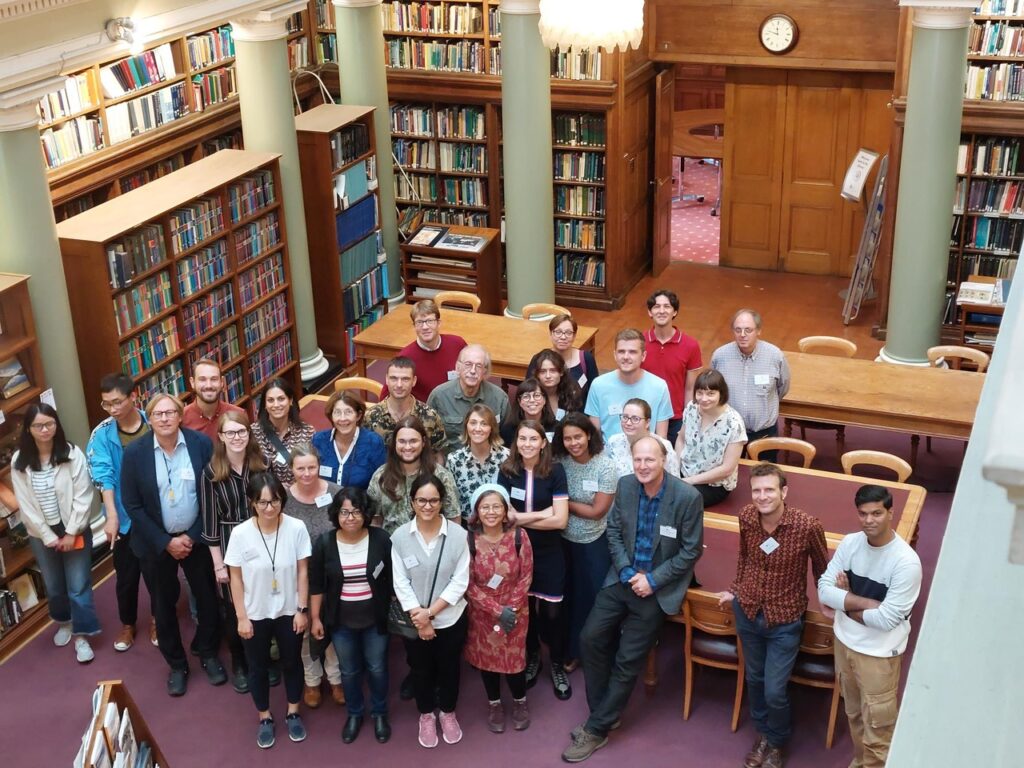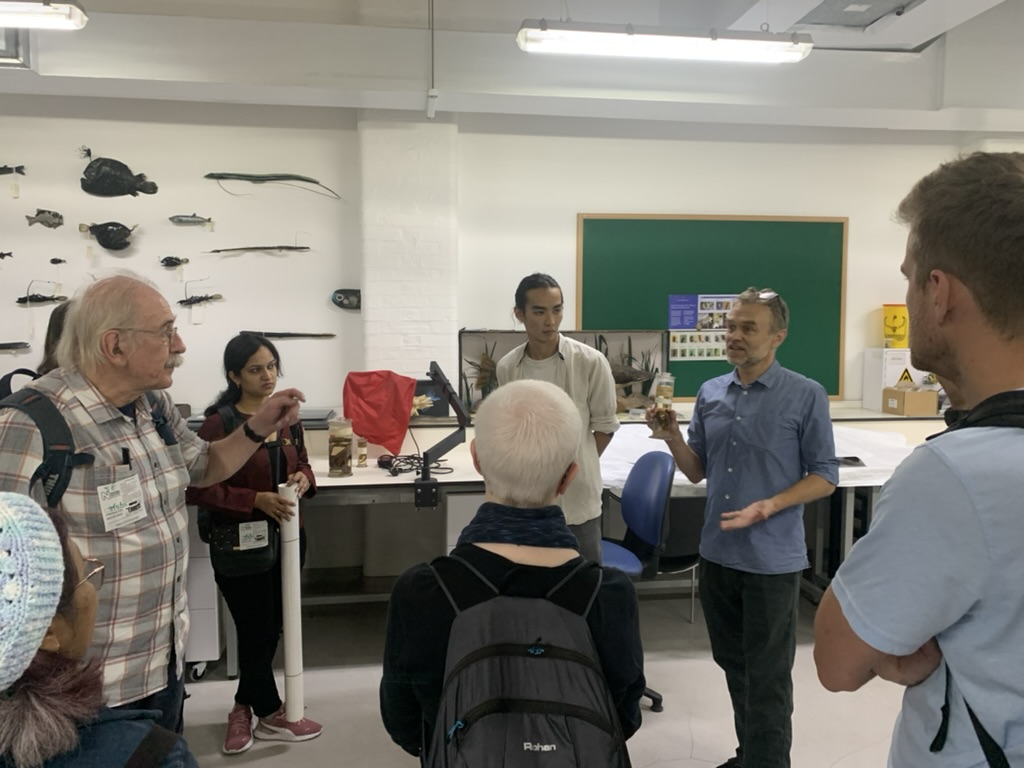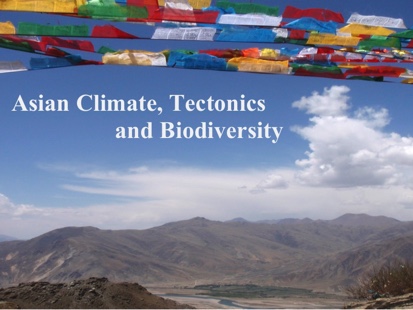
September 5-7, 2022
Geological Society, Burlington House, London

The conference has been a great success with over 60 participants worldwide covering Asian, Tectonics and Biodiversity with a variety of approaches bridging Earth and Life sciences. The abstracts are available were reorganised by regions in exciting sessions now available in the book of abstracts. The conference included a fantastic guided tour of the Natural History Museum.
A Special Publication gathering papers on the topic of the conference is now open for submission. Contact us for more detail.

We thank warmly the contributors, the Geological Society staff and collegaues from the Museum for this exceptional event. The conveners: Guillaume Dupont-Nivet, Tara Jonell, René Dommain and Peter Clift
Book of abstracts and program of presentations
Registration and Abstract submission (deadline Friday 24 June 2022)

Integrating paleoenvironmental with biological sciences is crucial in the context of Anthropocene climate and biodiversity crisis. This conference will focus on Asia, containing the most biodiversity hotspots, tectonically active and climatically sensitive regions in the world. A special issue will be proposed to gather publications stemming from the conference.
Convenors or organising committee:
- Guillaume Dupont-Nivet (CNRS – Potsdam University)
- Peter Clift (LSU, USA)
- Tara Jonell (University of Glasgow)
- René Dommain (Nanyang Technological University, Singapore)
Scientific Topic. How do tectonics and climate force surface processes and the evolution of biodiversity in Asia? This meeting will examine this long-standing question by unraveling coupled geodynamic and Earth-Surface processes that impact environmental conditions and the Biosphere across different spatial and temporal scales.
The focus will be on the India-Asia collision region at large, including widely different ecological environments such as the subarctic steppe of Central Asia or the tropical monsoonal forests of Southeast Asia. This region combines some of the most biogeographically diverse and tectonically active areas on Earth, as it straddles across the highest mountains and plateaus resulting from a complex geodynamic history throughout Phanerozoic times.
Past and present mountain landscapes are vital for building biodiversity. Mountain landscapes are hotbeds of speciation, accounting for over 85% of modern terrestrial mammals, birds and amphibians in only 25% of global land area. Over deep time, rugged mountain landscapes are shaped by the interplay of geological processes and climatic cycles that together promote habitat migration and fundamental processes driving the dispersal and diversity of life on Earth: speciation, persistence, dispersal, and extinction.
This meeting is relevant for researchers interested in a broad multidisciplinary approach to address some of the most fascinating challenges and current debates combining the Earth, Environmental and Life Sciences.
Timeliness and Importance. With ongoing human alteration of the Earth’s ecosystems and rapid global warming there is an urgent need to understand the response of species and environments to climate change. Modern observations only offer a limited perspective to study, therefore lessons learned from Earth’s past are essential for understanding how climate change affects the distribution and migration of species.
Examining how past climate change influenced biological diversity around topographically complex and tectonically active systems, forming hotspots where many species likely evolved, provides unique information about their ability to adapt to climate change. In return, life itself has impacted regional environments and surface processes, global biogeochemical cycles and even tectonic processes over geological time, thus forming a fascinating network of interactions and feedbacks.
The advent of molecular phylogenic tools, remote sensing information systems and biotic-based environmental proxies has led to an explosion of data and models to understand these interactions. Many international projects from hosts and other connected groups are currently yielding new enticing research paths.
Expected outcome. Attendants will present and learn developments in Earth-Life sciences interactions with a long-term, global perspective, which is particularly timely in the context of rapid climate change and anthropogenically-driven species extinction. Information extracted from contributions and breakout discussions will spark synergetic ideas and new transdisciplinary research alleys. Specific insight on how rapid climate and landscape changes impacted ancient life, will shed light on the origins and governing factors of biozones and thus inform conservation efforts.
Eventually, this information can guide policy decisions under projections for a rapidly warming climate to ensure we preserve biodiversity of our ecosystems into the future, which are essential to global economic, social and cultural prosperity. To cover the event, a GSL special volume and a blog are planned.
Provisional Program (PDF)
Day 1 AM. Emile Argand session. Asian Geodynamics, Orogenesis and Paleogeography
Keynote: Pr. Oliver Jagoutz. Earth, Atmospheric and Planetary Science, MIT, USA.
Determining accurate paleogeograhy through time of terranes transported from Gondwana over the Tethys to Eurasia has considerable implications on Biosphere evolution. However, the tectonic accretion of Asian terranes and associated orogenic uplift history remains unsettled. In particular, the onset, growth and relief of major topographic features, such as the Himalayas or the Tibetan Plateau are highly controversial and depend on hotly debated geodynamic models for the India-Asia collision. Understanding how topography has evolved is critical to constraining how this may have interfered with regional environmental changes (monsoons, Jet Stream, desertification) and affected global climate and the CO2 cycle.
Day 1 PM. Alfred Wallace session. The Fossil Record of Asian Paleobiogeography
Keynote: Pr. Carina Hoorn Institute of Biodiversity and Ecosystem Dynamics, Amsterdam, the Netherlands.
The rich fossil record of Asia informs us on the dynamic history of land masses and climate but importantly provides a window in which to explore the past conditions of organismic origins, extinctions and biotic interchange that cannot be studied with modern observations. In this session we welcome contributions on the paleobiogeography of Asia based on paleontological studies ranging from megafauna to microfossils from both the terrestrial and marine plant and animal realms. What can the fossil record tell us about biotic consequences of the continental collisions between India and Asia and between Australia and Asia in terms of biotic exchange and the assembly of biodiversity? How does palaeontology inform us on the evolution of endemic organisms that characterize Asian biodiversity hotspots? And can paleoenvironmental inferences from the fossil record be reconciled with independent paleoclimate reconstructions?
Day 2 AM. Amadeus Grabau session. Asian Climate, Environment and Ecological evolution
Keynote: Pr. Robert Spicer – Professor of Earth Sciences in the School of Environment, Earth and Ecosystem Sciences, Open University, UK.
Reconstructing the past evolution of Asian climate, environments and ecology are key to identify and understand controlling mechanisms and interactions between the Geo- and Biospheres. Major efforts are currently focused on building accurate proxy records and climate model experiments. Together, integrated data and models enable interpretations to be made using the geological past as a key to future predictions. However, the onset and intensity of major atmospheric, environmental and ecological components (e.g. monsoons, desertification, loess, C3-C4) remain controversial such that their driving mechanisms (regional paleogeography vs. CO2) remain hotly debated.
Day 2 PM. George Louis Buffon session. The Evolutionary path to Asia’s Present Biodiversity
Keynote:Dr. Thomas von Rintelen – Evolution and Geoprocesses, Museum für Naturkunde, Berlin, Germany.
The mountains of Asia and the islands of Southeast Asia host some of the richest biodiversity on Earth and support the greatest concentration of biodiversity hotspots on the planet. How did this exceptional diversity originate? The rapid development of molecular phylogenetic approaches has revolutionized our general understanding of diversification and biotic assembly over time and provides a timely opportunity to address outstanding questions on the evolution of Asia’s modern biota. How do phylogenetic, phylogeographic and genomic perspectives challenge or support existing models on centres of origin, species dispersal, vicariance and the diversification of fauna and flora in relation to past climate change and tectonics across Asia? Do integrated phylogenetic data sets from different taxa show congruent or individual evolutionary responses to geodynamics in this tectonically active region?
Day 3 AM. Alexander von Humboldt session. The interactions of Life and Earth
Keynote:Pr. Robert Morley – Life Sciences and the Environment, Department of Earth Sciences, Royal Holloway, London, UK.
Alexander von Humboldt developed a deep appreciation on the linkages between the biosphere, climate and geosphere, which inspires the desire for reintegration of modern bio- and geoscience observations under a more holistic approach to decipher the interactions and feedbacks between life and Earth. Asia provides unique settings to study the interactions of geological processes, climate dynamics, biotic evolution and ecological responses on various spatial and temporal scales. This closing session hosts integrative studies that focus on deciphering the connections between abiotic phenomena (e.g. Earth surface processes, climate variation, soil development, hydrology) and the biosphere in terms of species richness, evolution and in shaping biogeochemical cycles and feedbacks. How does the geosphere control biotic processes and in turn how does the biosphere modulate Earth’s surface and climate?
Day 3 PM. Excursion to the Natural History Museum
